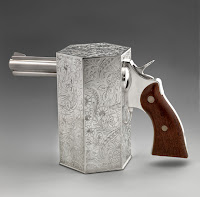These are loaded terms--CRAFT and DECORATIVE. They imply less impressive circumstances of commissioning and viewing, less expensive materials, not within the Salon hierarchy of value placed on "fine arts", less skillful artists whose names we often don't know. We picture baskets and grandfather clocks and silver table settings. You've been to those nearly empty galleries with dusty roped off chairs and brocade settees and been frustrated because all you'd like to do is sit down for a moment. We're not taught well how to look at these objects because we see them every day. We "get" the idea that these are nicer bowls than what we eat cereal in just from the context that they are in a museum but we don't know how to think about them in the place of history.
There's more than one aspect of this discussion going on. There's clearly the preservation mission of the museum. To recognize the traditions of making an object that link it to a regional or period way of working with the materials is what leads us to understand colonial American silver or Gullah baskets. These are styles and methods that will disappear with time, new social priorities and aesthetics, globalization/cross-pollination.
 |
| Gullah Fanner Basket, Lynette Youson, 2002 |
 |
| Tea kettle, Kierstede, 1710, silver |
But the Renwick focuses on 20th and 21st century works, and there's a duty here to bring viewers into the issues of contemporary art as applied to these media. To realize that when we understand the traditions of silversmithing in America, we can see a work like Tea for One, by Jeffrey Clancy, 1976 and maybe see the commentaries on silverwork, on tea as a social phenomenon, on gun ownership in America, the blend of "ornament and utility" that this is part of the artist's series. There's a beauty and a danger here.
 |
| Jeffrey Clancy, Tea for One, 2002 |
The Renwick is showcasing some new galleries with works like Jennifer Angus's In the Midnight Garden that draw attention to our lived environment (and for me, the traditions of wallpaper under William Morris and the Victorians/Edwardians). Her use of cochineal dye, made from insects, and the careful patterns of flowers, whirls, and skulls create a vibrant and vivid space. The materials are bugs themselves--drawing attention to our natural world and our interdependence. “Our mortality is closely linked to the environment,” she said. “The fact of the matter is we can’t live without insects.” (from NYT article) What draws me to this work is that it is part of our space; it shapes our whole experience.
 |
| Jennifer Angus, In the Midnight Garden, 2015 |
This is somewhat a false distinction as artists are still working in the studio, some with fine materials, some with delicate and technically intense methods. BUT...the sense that "decorative" art is conversationally engaged with its audience, in a way that the "high" arts of painting and sculpture have always been acknowledged to be doing, is an important change.
Take a moment to watch their 2 minute video on the upcoming show and opening, Wonder. You'll be amazed at where contemporary "craft" is going:
No comments:
Post a Comment